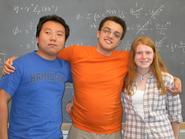
Physics students Michael Gregg '08 (Albany, N.Y.), Yubo Lu '07 (Shanghai, China) and Julia MacDougall '09 (Wilmington, Mass.) are working on summer research projects involving the theory of Quantum Gravity with Associate Professor of Physics Seth Major. The theory of quantum gravity is the "missing link" in a unifying theory between quantum mechanics, which deals with a small scale, and the theory of general relativity, which looks at the larger scale.
Gregg, a pre-med physics major who is spending his first summer on the Hill doing research, is studying two spacecrafts, Pioneer 10 and 11, which are traveling away from the solar system. Scientists have noted that there is an acceleration acting on them that physics has not been able to explain. Gregg is applying Major's model of quantum gravity in order to try to explain that acceleration.
MacDougall is working on a project in particle physics. "Particles come from outside the galaxy, hit objects in our galaxy, and make other particles," explained MacDougall. When particles reach Earth, scientists expected them to have energies lower than the threshold energy derived in 1966 by the American physicist Kenneth Greisen and Soviet physicists Georgi Zatsepin and Vadim Kuzmin. However, some anomalous particles have higher energies than the threshold predicted. MacDougall is using this calculation, the GZK cutoff, to explain and redefine the higher threshold energy. MacDougall is a physics and geology major and participated in physics research last summer as a pre-freshman as part of the STEP/Dreyfus program. She hopes to pursue studies in geophysics after graduating from Hamilton.
Lu, who worked last summer with Professor of Physics Ann Silversmith, is studying gravitational waves and the corresponding quanta graviton in the early universe. Gravitational waves are "normal waves," explained Lu; that is, they are spacetime oscillations. However, under the theory of quantum gravity, spacetime is considered discrete rather than continuous, which means there exists the smallest unit of spacetime that cannot be further divided. Lu is working on deriving a modified version of the wave equation for the DeSitter era under the assumption that spacetime is in fact discrete. By solving that differential equation and relating the solution to that of the existing wave equation of the radiation-dominated era, Lu hopes he can have a better understanding of the spacetime geometry of the early universe. Lu is a math major and physics minor and is considering law school after Hamilton.
While the students enjoy their research, they agree that it has its challenges. "We're jumping in both feet first into something we had no idea about," said MacDougall. Because quantum gravity is theoretical physics, Gregg, MacDougall and Lu spend their days with books, research papers and paper and pencils rather than working on experiments in a wet lab. They are working a concept that no one truly yet understands. "There are more wrong explanations than right," said Gregg.
While the research is difficult, Gregg, MacDougall and Lu agree that it is exciting to work on quantum gravity, which is the "cutting edge of theoretical physics."
-- by Laura Trubiano '07
Posted July 24, 2006
